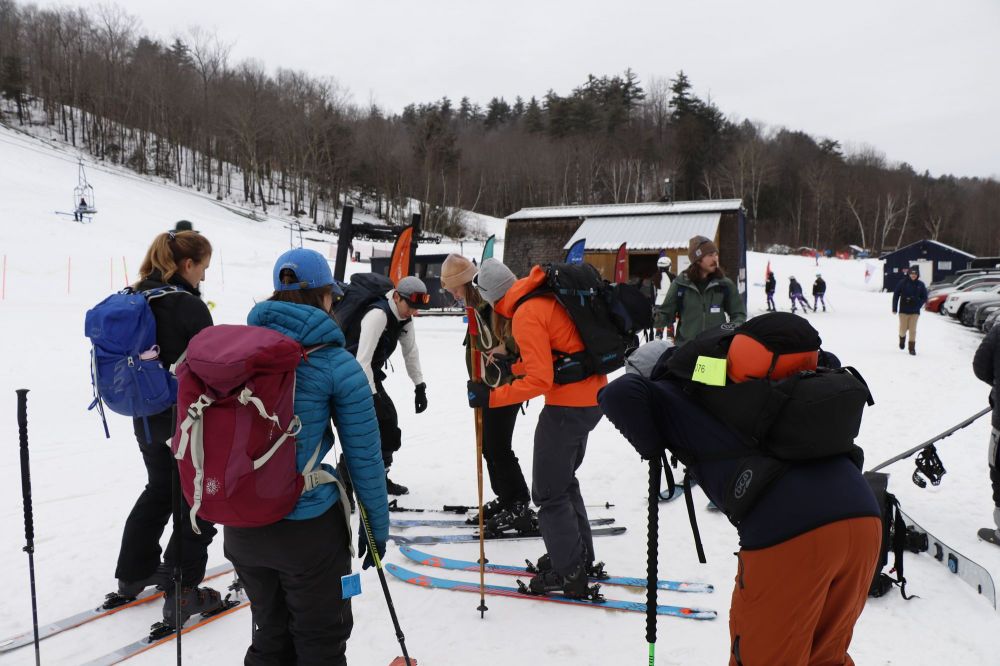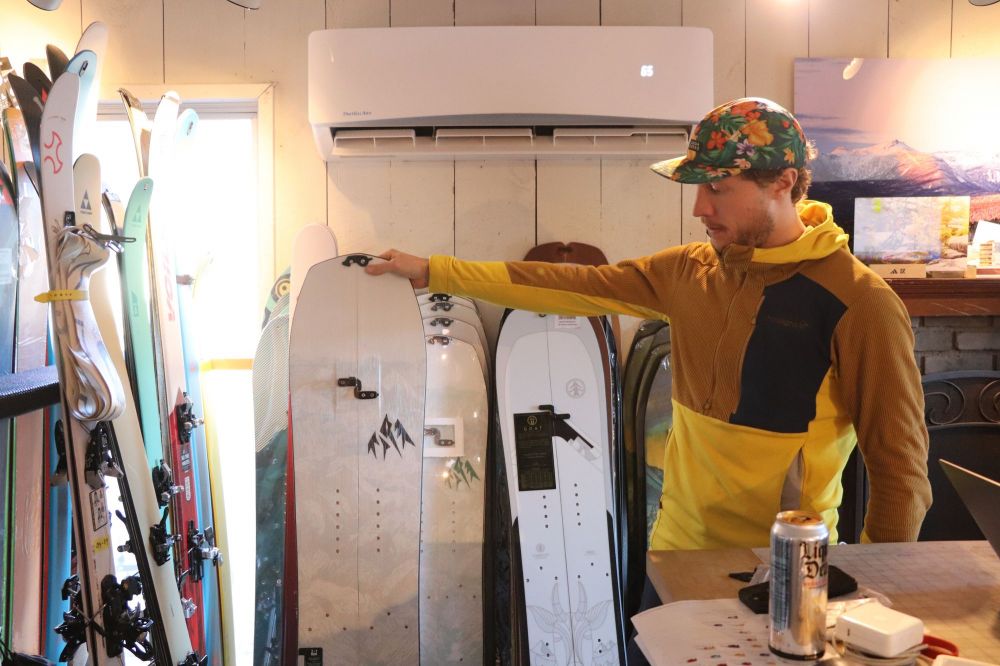This is the fourth in a five-part series on New Hampshire skiing in the age of climate change. You can find the introduction here and the second article, on the challenges facing the state’s smaller downhill areas, here. The third installment, on nordic skiing, is here.
When Ed Warren suits up to go skiing, he’s hoping to catch some fresh powder in the backcountry. The Lebanon, NH native holds the record for the fastest ski from Pinkham Notch to the summit of Mount Washington and back down again. But last summer, he became the founder and managing director of a group that advocates for skiing not in the backcountry: Uphill New England is a nonprofit that facilitates uphill skiing and snowboarding (also called splitboarding) on groomed resort trails.
Human-powered skiing and snowboarding—eschewing lifts and climbing up trails with adhesive ‘skins’ strapped to your skis—has seen a dramatic rise in popularity during the past few years. But this change has been quickly followed by a shift from the backcountry to the frontcountry.
“The backcountry is great. The backcountry is [...] the preference,” Warren says. “But the reality is that the snowpack in New England is extremely unreliable.”
Especially in low-snow winters like this one, when rain events are common and frequent thaws compromise snowpack, Warren and his fellow backcountry enthusiasts have no choice but to ‘uphill’ on groomed trails and manmade snow.
That means when they clip into their skis and begin an ascent, they’re often looking at the underside of a chairlift, not a breathtaking White Mountains view.
Skiing ‘on a treadmill’
Southern New Hampshire resident Justin Culligan, who has been a human-powered skier for ten years, compares uphilling at a resort to “running on a treadmill. [...] It gets the need for exercise and you’re still out in the fresh air and you’re enjoying being in the mountains.” Still, he says, “the backcountry is where I prefer to be.”
When he can’t ski in the backcountry, Culligan usually arrives at Pats Peak Ski Area in Henniker around 5:30 or 6 AM on weekdays to get a few uphill laps in before work.
He’s found himself spending more time on manmade snow “especially in the last four or five years,” he says. His “go-to early season backcountry tour is the Sherbie”—the John Sherburne Trail on Mount Washington. When Culligan first started backcountry skiing in the early 2010s, he recalls, “it was pretty regularly available to ski by, like, December 10th. The last three, four, five years,” he’s been “lucky to get up there even by mid-January.”
‘Less intimidating than I thought’
The recent focus on resort skiing does have a silver lining for those interested in trying out human-powered skiing for the first time.
Katie Berdy, 26, of Hanover, learned the mechanics of uphill skiing through an introductory event held at Whaleback Mountain in January. Berdy, who was interested in uphill skiing more for the exercise than for the adventure, was content with a few laps up Whaleback’s 700 vertical feet.
“It was very fun,” Berdy said after finishing a lap. “It was less intimidating than I thought.” Asked if she was interested in venturing into the backcountry, she said, “I’m pretty risk-averse to avalanche conditions, so I probably will just do things like this.”
Her experience was made possible by Inclusive Ski Touring, a group Zachary McCarthy began in 2021 to help bring new people into the world of human-powered skiing and splitboarding.
McCarthy’s goal was to break down the “holier-than-thou culture” that he felt was making it harder for newbies without the right experience, equipment, or connections to join the backcountry ski community.
“I think [...] people are realizing that ski touring or splitboarding doesn’t have to be this crazy backcountry skiing that you might see in movies, but it can be as simple as skinning up the resort in their off hours and being able to ski back down,” McCarthy explains.
Inclusive Ski Touring offers scholarships, cost waivers, and gear rental discounts for ‘Open-to-All Programs’ like the one Berdy participated in, as well as trips specifically for skiers and boarders from underrepresented backgrounds. Their cheapest option, according to McCarthy, is $45 total for discounted gear rentals, a group uphilling lesson, and an uphill pass at Mount Abram in Greenwood, Maine.

Inclusive Ski Touring trip leader Josh Chang leans down to help a beginning ski tourer strap into her skis on a January day at Whaleback. (Photo: Beatrice Burack)
‘We kind of keep our sanity with manmade snow’
Uphilling also carries a silver lining for Andrew Drummond, owner of the White Mountain Ski Company in Jackson. Drummond, who first opened his ski shop in 2016 after struggling to find backcountry ski gear for sale in the Mount Washington Valley area, finds himself in an industry that is both rapidly growing and extremely volatile.
During a rainy Christmas week, Drummond predicted that his shop would rent less backcountry gear than usual, but noted that skiers renting gear for uphill resort skiing would help his bottom line—if the resorts stayed open, that is.
“We kind of keep our sanity with manmade snow. It’s what enables us to get outside and ski. But right now, even with manmade snow, it’s not good because you can’t uphill at most resorts,” he said, pointing to the unusually rainy and snowless late-December weather.
A true New Englander, Drummond is prepared for “what[ever] activities mother nature’s letting us do” on a given day. His shop sells fatbikes, hiking boots, and nordic ski gear for waves of warm and snowless weather that even the resort snowmakers can’t ride.

A White Mountain Ski Company employee shows off one of the shop’s splitboards—a snowboard adapted for uphill use. (Photo: Beatrice Burack)
‘There’s always the hope that there’s going to be that big winter’
Drummond worries for the future of his industry. Outdoor recreation “affects our economy big-time up here,” he said. “Skiing is part of our history, it’s part of our community, and it’s part of our economy. Of course we should reduce emissions and we should reduce wasting power and think more climate-forward.”
Still, he hopes to “have lots of fun days in the mountains with great people” in years to come.
Tyler Ray, director of the Granite Backcountry Alliance, a group he founded in 2016 to open up more backcountry ski trails in New Hampshire and Western Maine, also has hopes for plenty more snowy winters to come.
“I like to keep the optimism up. I think, as an East Coast skier, optimism is a big part of the game,” Ray says.
In seven years, he says, he and his team of volunteers have spent over 33,000 hours opening up 50,000 vertical feet of skiable terrain. But warming winters have meant more time uphilling at resorts and sometimes “only a week or two” when the backcountry skiing is “really, really good.”
“For most people, that sounds crazy,” he says. “Why would you create that sort of investment with that return? But there’s always the hope that there’s going to be that big winter.”
And when the snow does come, “you have to get out there and get it” in the backcountry.
Beatrice Burack is a Granite State native and a junior at Dartmouth College working as a freelance journalist in the Upper Valley. Her work has appeared in the New Hampshire Bulletin*, NHPR,* NH Business Review*, and the* Valley News*, among other publications. She can be reached at bea.c.burack.25@dartmouth.edu. Her exhibit on NH skiing in the age of climate change opened in Reiss Hall in Dartmouth’s Baker Library on Monday, March 11th. It will stay up through May.*
These stories were first published in Daybreak, an email newsletter focused on the Upper Valley, New Hampshire, and Vermont, and are being shared with the partners in The Granite State News Collaborative.
